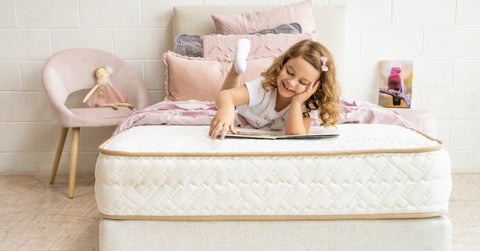Home and Decor
7 min read
How To Choose The Best Bed For Your Child
October 10 , 2025
By Sharib

Choosing the right bed for your child is a significant decision that affects their comfort, safety, and development. The bed should provide a cozy space for your child to sleep and support their growth and changing needs. Whether your child is a baby, toddler, or older, their bed should fit their size and age. As they grow, their bed should adapt to ensure they are safe and comfortable. A bed that is too large or small can create insecurities and even lead to accidents. Moreover, as children become more independent, they may begin to explore their beds and surroundings, making safety features like guardrails essential. In this blog, we will discuss the key factors to consider when buying a bed for your child, from age-appropriate choices to long-term usability, ensuring you make the best decision for their well-being.
1. Understand Your Child’s Age and Needs
Before you shop for a bed, consider your child's current age and how quickly they are growing. Toddlers, pre-schoolers, and older children all have different sleep needs and safety requirements. Consider your child's transition stage and how long you want the bed to serve them. Some parents prefer a bed that can grow with the child, like those that convert from toddler-size to full-size options.
- Toddlers (1.5 to 3 years): These little ones need a bed that keeps them low to the ground for easy access and avoids injury from falling. Toddler beds are ideal at this stage.
- Pre-schoolers (3 to 5 years): Kids at this age are more adventurous. You might consider a low-profile twin bed, possibly with removable guardrails for added security.
- Older children (6+ years): These children are more independent and can usually handle standard-height beds. Now is the time to look for something that will last through their growing years.
2. Prioritize Safety at Every Step
Safety should always be the top priority. Children tend to move around a lot in their sleep or may attempt to climb in and out of bed on their own. Also, remember that where you place the bed matters, too. Avoid putting it near windows, heaters, or shelves, which could pose a hazard. Here are some safety tips to consider:
- Look for beds with rounded edges to avoid injuries.
- Make sure the frame is stable and strong, with no wobbling or sharp corners.
- Choose a bed that is low to the ground, especially for younger children, to prevent serious falls.
- If your child is a toddler, guardrails are important to keep them from rolling off the bed.
- Regularly inspect the screws and joints to ensure the bed stays in good condition over time.
3. Choose the Right Size and Type
- Not every child needs the same size bed. Your child’s room size and future growth should guide your decision.
- Toddler beds are great for young kids who have outgrown cribs. They often come in fun shapes and colours.
- Twin beds: A popular choice for pre-schoolers and up. They offer more space to grow without taking up too much room.
- Full-size beds are ideal for older children or for those who want a bed that will last them well into their teenage years.
You can also consider bunk beds if you have more than one child sharing a room or if space is limited. However, to prevent accidents, these should only be used for children aged six and above. Think about how much space the bed will take and how it fits with other furniture. Always measure the room before making a final decision.
4. Consider Comfort and Mattress Support
The bed frame is just one part of the sleep equation. A good mattress is just as important to ensure your child gets quality rest. A bed that feels too hard or too soft can interfere with sleep quality. Moreover, remember that children's sleep is crucial for their brain development, growth, and mood. Here is what to look for:
- A medium-firm mattress offers both support and comfort for a growing body.
- Ensure the mattress fits snugly within the frame with no gaps around the edges.
- Opt for hypoallergenic materials if your child has allergies or sensitive skin.
- If possible, test the mattress before buying. Your child can lie down on it for a few minutes to see how it feels.
5. Think Long-Term and Multi-Functionality
Children grow quickly, so it is smart to think beyond just their current needs. Look for a bed that can adapt to changes as they age. These smart choices can save you money in the long run and help keep your child’s room organized and clutter-free. Always keep flexibility in mind when picking a bed. Multi-functional beds are especially useful:
- Storage beds come with built-in drawers or shelves, which are great for saving space.
- Convertible beds grow with your child, transforming from toddler size to larger sizes.
- Loft beds free up space underneath for desks or play areas, perfect for small bedrooms.
6. Match the Bed to Your Child’s Personality
A bed can also reflect your child’s tastes and interests. While it is important to keep the design practical, you can still let their personality shine. When kids love their bed, they are more likely to feel comfortable and secure. Just remember to keep things flexible in case their interests change in a few years. Let your child be part of the decision-making:
- Choose colors or patterns they like.
- Look for themes that excite them, whether it is nature, outer space, or simple minimalist styles.
- Involve them in setting up the bed or choosing the bedding; it helps build a sense of ownership.
7. Budget Wisely and Look for Quality
While every parent wants the best for their child, it is essential to stay within a reasonable budget. You do not need to spend a fortune to find a quality bed. Think of the bed as an investment in your child’s well-being. A good night’s sleep can improve their mood, learning, and energy levels. So, while being cost-conscious is wise, try not to compromise too much on quality and comfort. Keep these budget tips in mind:
- Focus on sturdy construction over fancy designs.
- Check reviews or ask for recommendations.
- Sometimes, simple beds last longer and adapt better to changes in the room.
To conclude, choosing the best bed for your child does not have to be overwhelming. By considering your child's age, safety needs, and future growth, you can find a bed that will provide comfort and support for years. Start with safety, ensuring the bed is stable and appropriate for their stage of development. After that, consider comfort, room space, and how the bed will fit into your child's life and personality. Choose something that can grow with them, offering flexibility for the future. The perfect bed should create a cosy, safe space for sleep and blend well with your child's routines and preferences. Remember, a good bed is an investment in your child's well-being, helping them feel secure and rested as they grow. With these tips, you are on the right track to choosing a bed that is just right for your child’s needs and your family’s lifestyle.
live smarter
Shop smarter, live better, and stay ahead of the trends with our reliable recommendations!

Health and Beauty
7 min read
The Ultimate Guide to Enhancing Health and Wellness with a High-Protein Diet
trending
Home and Decor
6 min read
How Can You Decorate with Plants Without Overdoing It?
Home and Decor
6 min read
How Do You Mix Vintage and Modern Decor Like a Pro?
Home and Decor
5 min read
How to Use Home Fragrance as a Decor Element?
Home and Decor
5 min read
How to Use Throws, Cushions & Rugs to Define Your Decor
Home and Decor
7 min read





